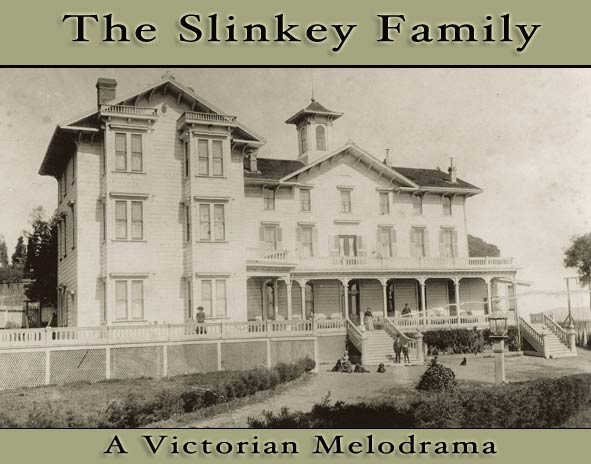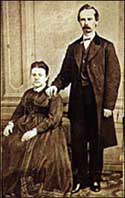Cast of Characters
John E.
Christina
Daniel
Lillian
Milton
Francis
Image Gallery

The El Monte Hotel in Sausalito, California, operated by the Slinkeys in the 1880s and 1890s.
My Slinkey ancestors came to California in the 1860s. Over the next sixty years their lives featured literature, opera, lavish banquets, and social climbing. There were also mysterious births, suicides, bankruptcies, murder accusations, train accidents, fires, a great earthquake, and lots of little fibs. In short, a typical Victorian family.
The Short Version

My fourth cousin, Randolph Baxter is to be credited with much of the original research that tells this Slinkey story. His work was a great inspiration for me to delve into genealogy and history in general. Most of the photos were saved by my uncle, Steve Slinkey, who graciously allowed me to copy and share them. My thanks to you both!
The Slinkeys truly started in San Francisco, California where the family name was created when Johann Emil Schlinke became John Emil Slinkey two years after his arrival from Australia in 1866. He ran away from his debts, embezzled from his employer, and seems to have been ducking out on a woman that he got pregnant in Adelaide. In San Francisco, a regrettable incident stealing money from a widow led to a name change. His future wife, Christina Dern, beat him to the city by a year or two. She's listed in the San Francisco directory of 1865 as a widow renting rooms. Here was a single woman, apparently working alone in a wild city 6,000 miles from her birthplace in Germany—the hows and whys are unknown.
John met Christina and they married in 1868. Their daughter Lillian may have been born a few months earlier, maybe even in 1867. Who can say if she was even Slinkey's daughter at all? The Slinkey legacy is one of "maybes" and "who knows?"
Through the 1870s the Slinkeys became more successful with a boarding house on Market Street, then a hotel on Sacramento (next door to the city's well-known "What Cheer House"). The Slinkeys began looking outside of the big city for opportunities. In 1879 they moved to Martinez where they ran a resort and picnic grounds, attempting to lure day-trippers and large groups to ferry from San Francisco. Soon after, they hit gold by taking over a large hotel in Sausalito, a town far closer to San Francisco and just opening up for greater development. Here the family reached the apex of its financial and social success. Family members from both sides immigrated to the U.S. to share in the prosperity. John's brother Daniel left Australia, and from the opposite direction Christina's relatives, including her father, arrived from Germany.
J.E. Slinkey acted as an officer in several fraternal organizations, took over the operations of the town newspaper, and, in the words of author and historian Jack Tracy, "had a hand in almost everything that happened in Sausalito." The "El Monte Hotel" had a number of satellite cottages, and while the establishment definitely catered to the better sort of visitor, the Slinkeys made sure to have activities and amenities for locals as well. Dan Slinkey helped around the place and Christina's youngest brother John Dern acted as an able bartender.
Despite the awkward situation of two Slinkey sons, Francis and Milton, born just a few months apart in 1883 (older sister Lillian was in her teen years and likely the mother of one), the Slinkeys definitely began to emulate the higher classes of society. Lillian hosted discussion groups on the writing of Sir Walter Scott, and gave recitals showcasing her vocal training. She studied opera in San Francisco and eventually traveled to Italy to further her education.
John Slinkey was the chief instigator of a fraternal organization called the "Society of Old Friends", which hosted "Bull's Head breakfasts" that actually featured the head of the animal, a Victorian delicacy. His brother Dan had difficulty going along with the high society program, acting as the official Sausalito poundmaster (dog catcher), and unofficial wag and drunk. The newspaper publicized his comic plans to discover oil in Sausalito, to build a bridge to Angel Island, etc.
The Gilded Age of the 1880s rolled into the financial panics and depressions of the 1890s. The Slinkeys suffered in a predictable manner: the hotel was lost, Lillian was recalled from her European adventuring, and Dan had a few too many "accidents" with boats and trains that resulted in a near-drowning and an amputated arm.
The financial fall wore on Christina, who seems to have suffered from bouts of depression her whole life. She committed suicide in January 1899 in the small boarding house the family had retreated to operating in San Francisco. Extending the tragedy, an anonymous letter-writer accused John of poisoning his wife. Christina's body was exhumed, an autopsy done, and John was exonerated.
Just a couple of months after this whole terrible affair, Dan Slinkey finally succeeded in taking his own life with an overdose of morphine.
Doubtlessly reeling from all this, John Slinkey soon after struck out on his own for Seattle, Washington. There he tried to establish many of the same businesses he was successful with in the Bay Area (real estate and hotels).
Lillian used her training to teach music in San Francisco. No doubt to add some allure to the services she offered, she adopted the name "Madame Durini." Our best guess is "Durini" was intended as an Italian version of her mother's maiden name of Dern. She lived most of her adult life with her uncle, John Dern, and in at least one San Francisco directory he appears as "John Durini."
John Slinkey returned to San Francisco just in time for the 1906 earthquake and fire. The Slinkey residence on Leavenworth Street burned to the ground, and like thousands of San Franciscans, the group had to seek refuge in one of the tent cities that arose in public parks.
This latest disaster actually proved fortuitous for Milton, who met his future wife Ethel Neate in the refugee camp and found a trade as a carpenter in the rebuilding of San Francisco.
John eventually struck out for the booming town of Goldfield, Nevada, where he may have met and married his last wife Hattie Neitbahn. They returned to San Francisco to see the infant son of Milton and Ethel in 1913. This child, Eugene Dalbert Slinkey, was my grandfather. Born after Ethel had lost a number of previous pregnancies, Eugene always reported he was very spoiled and had a terrific childhood.
John Emil Slinkey died in March 1920. For decades he had been known as "the Colonel," and Lillian was sure to include a phony Confederate veteran's pedigree in his obituary. Lillian died in 1937. Milton and his wife lived into the 1950s and were remembered as loving grandparents to Eugene's children, including my mother.
